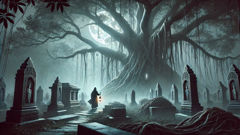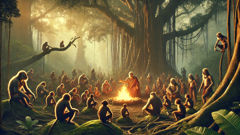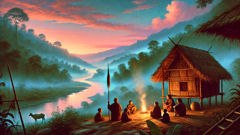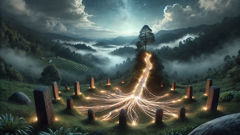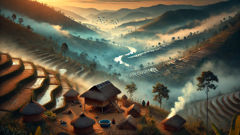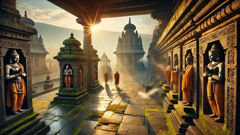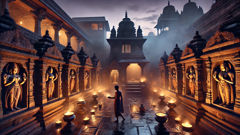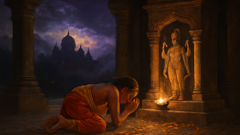Introduction
In the low valley where the river curved like a sleeping snake, where mango trees held their sweetness for those who could wait, the name Brahmaparusha was spoken as much for its sound as for its warning. Old men muttered it into their toddy, mothers wrapped it into lullabies that softened into shushing hushes, and children learned to sidestep the shadowed path after dusk because of a single, terrible image: a thin silhouette moving just at the edge of the ricefields, head cocked as if listening to a frequency only it could hear. The Brahmaparusha, they said, did not merely take life. It wanted intelligence, memory, the warm, organizing center of a person. It sought the small, private sunlight that lives behind the bones: the brain. No brimstone thunder accompanied its coming, only the slow, intimate silence of minds unthreading. That silence could be sudden—a man found at dawn, uncomprehending and empty-eyed, fitting himself into meaningless repetition like a puppet whose strings had long since been cut. Or it could be quieter, decades of subtle emptiness as one after another lost the sharp corner of a joke, the remembered path to the potter’s kiln, the precise way to call a child by the pet name that no one else used. Here, in that valley, memory was currency and identity was thin as paper during monsoon. To lose either was to lose everything. The Brahmaparusha legend explains not only fear of a creature but the human response to the erosion of memory: the rituals, the stories, the small innovations that communities build to ward away the slow dark. Over many seasons the valley learned to mark time differently: to sleep with brass lamps when the moon was new, to leave bitter neem leaves on thresholds, to chant certain lines at the first rooster’s call. In this story I will trace the origin tales that the elders tell—how a scholar’s pride birthed a curse, how stubborn devotion and a simple girl's courage turned the tide once, and how the modern world’s telescopes of reason both challenge and reinterpret the old warnings. These tellings are not mere entertainments; they are mnemonic devices, cultural rudders that steer everyday caution. They teach practical remedies and preserve a vocabulary for something that feels inexplicable and personal. The Brahmaparusha is as much a story about communal imagination as a monster itself. Even if you have never stood in that valley at midnight, you will recognize the feeling: the hush before voices fail, the way people gather close to trade memories like brittle, cherished coins. In these folds of speech, terror becomes knowledge, superstition becomes practice, and the story becomes a tool the living sharpen to defend their sleep. Listen carefully, and you will hear the names of those who fought and those who were taken, the soft details that make a legend believable and keep a village from becoming a ruin.
Origins and Omens: How the Brahmaparusha Came to Be
The earliest tellings say the Brahmaparusha began not as a demon of the night but as a consequence of exquisite human failing: a scholar's pride and a misapplied ritual. In one version, a priest-scholarly man named Vidhyadhar pushed beyond the limits of sacrament into an arrogance that wanted to possess the very essence of thought. He performed rites to secure memory itself, reciting mantras to bind knowledge to his own name. The gods, or fate, depending on who tells it, balked. The desire to hoard intelligence, the tale warns, is a sacrilege against the river of human exchange. In a flash of climactic folklore logic, the boon Vidhyadhar sought reversed, and the hunger his ritual created leapt free of his body and took the form of a hunger that could not be sated with meat. It sought the living mind.
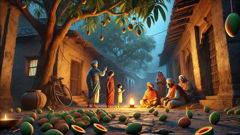
The Brahmaparusha's appetite is described with a specificity that makes the name sticky in oral culture. It does not merely drink blood like other vampiric figures. The villagers say it tastes the patterning of memory, the luminous filigree of associations that make an individual clever where another is merely attentive. Children with bright imaginations seemed at first to attract it more easily; poets and weavers of proverbs were prized targets, because the spirit coveted what made a person unique. This detail serves as the story's practical core: it makes people guard not only their sleep but also their public life. They learn to code their knowledge in commonplace gestures, shove some important instructions into songs, use a child's rhyme to hide a secret recipe. Saying a line in a certain way becomes a lock. Knowledge becomes not purely private but performative, and that performance is the village's protection.
Omen stories accumulated. A rooster crowing three times with a single broken chord, a dog gone silent at midnight, the sudden and inexplicable forgetting of a neighbor's name—each was pinned as a possible first sign. One recurring portent involved the mango trees. When the Brahmaparusha prowled near a courtyard, the fruits on a stem would fall all at once; they called it the „shedding of small suns.” People watched the trees and learned to read their tumbled fruit as one more surveillance system; the orchard took on a role usually reserved for elders. Mothers taught children to memorize the pattern of mango fruit on their tree: if the pattern changed overnight, someone should stay awake.
Yet the legend resists being merely a horror story. It is genealogical lore that explains how knowledge and forgetting travel across generations. Where epidemics of amnesia would break down kinship roles and economic functions, the Brahmaparusha story prescribes remedies. Salt is set by doorways not only to keep away stray animals but as a symbolic barrier that, according to the old men, disturbs the creature's appetite. Lamps of ghee and brass are kept burning on thresholds and near cradles; the flame is described as a small, focused intelligence that the spirit finds corrosive. The villagers placed mirrors near the foot of beds during the new moon to multiply presence; if the spirit comes, the mirrors mean more eyes to watch. There are talismans, too—tiny clay beads inscribed with the first syllables of favored spells, or a lock of hair kept in a leaf, or a child given the name of an ancestor, said aloud in the dusk, to tether them to a living memory outside the house. Here the tale becomes practical anthropology: a map that shows how societies ritualize the safeguarding of collective cognition.
Scholars who later recorded the legend traced another thread: the Brahmaparusha as a cautionary figure against solitary brilliance. Across India, social memory has been historically distributed—knowledge passed through apprenticeship, song, and the shared labor of crafts. The Brahmaparusha story insists on the sociality of knowing. It tells the lonely scholar to sit among others, it makes hoarded bookishness a dangerous thing. In that way the legend performed a kind of social engineering; it kept towns from fracturing under unequal control of knowledge. There are versions where entire families saved themselves by making sure no single person held an entire practical skill—cooking methods are split into parts, a chant is given in alternating lines, and the secret of a medicinal plant is learned by three people so that if one is taken, the community still holds the cure.
The most human part of these origin tales is the recorded tragedies. The names of those taken are often recited during drought or when elders worry about the young wandering toward the city. They become mnemonic anchors: Tanuja who could remember every face, Ramdas who maintained a ledger of debts, little Bhanu with his uncanny counting of stars. The story preserves their loss as both lament and lesson. Generations speak of a winter when many elders fell silent after a fever season—some say the Brahmaparusha capitalized on disease, slipping into the stillness, while others argue the tale grew to explain the real structural losses that come with famine and migration. The legend, versatile as it is, folds those larger causes into the figure of a creature that makes individual forgetting feel like an external theft rather than internal attrition. That framing, though terrifying, also galvanized practical action: communal watches, yearly recollection festivals, and sacramental exchanges where elders orally audited families like librarians checking out books. In that way memory was curated as a shared resource, and the Brahmaparusha, paradoxically, inspired a deeper social cohesion.
Encounters and Countermeasures: Nights of Vigil and the Quiet War
Encounters with the Brahmaparusha are told like weather reports—some are local, pointed and vivid, others remain dreamlike and abstract. In one household an orchard worker returned from the fields to find his father standing by the hearth, moving his hands aimlessly at the same phrase. When asked, the father could no longer name the worker’s wife. In another, a potter forgot how to fashion a spout and began making jars with the rim uneven, as though some internal diagram had been erased. The terrifying thing villagers noticed was not always the immediate collapse of a person’s faculties but the slow unravelling: a familiar tune losing its bridge, a neighbor repeatedly asking the same question in a single day, a boy who had been able to recite long lists now reduced to parroting a single line. Those small fissures signaled the presence or approach of the Brahmaparusha.
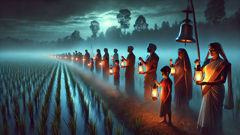
The village responded in ways that blend the sacred and the pragmatic. Early on, villagers organized what they called „quiet wars”—nights of vigilant listening rather than hunting. A watch rotated at the edge of the fields where the light met the dark. Watchers carried copper bells and small gongs. The sound was not for violence but for continuity; it kept rhythm with the villagers' shared memory. When a bell rang, those inside repeated a line of song, a proverb, or a litany known to elders. The rhythm of bells and recitations created a palimpsest of human patterning that the legend claims the Brahmaparusha finds irritating and hard to penetrate. Practical measures extended beyond auditory tactics. Houses sealed cracks with sticky red clay; they hung bundles of neem and turmeric not only as insect repellents but as symbolic bitterness the spirit would not cross. Parents would teach children to answer questions with a small code of communal syllables when someone outside the inner circle asked about a secret—this made the divulging of critical knowledge a deliberate, witnessed act.
There are episodes in the archive of oral accounts that read like detective stories. One such tale involves the village of Patalgram, where for a season several people started waking with the same static phrase on their lips, as if the spirit had left a stamp. The elders, remembering the old logic that the Brahmaparusha is drawn to solitary brilliance, decided to convert the town’s marketplace into a school of sorts: every morning the folks with skills—carpenters, weavers, midwives—would stand at the stalls and teach a two-line technique to anyone who came. A secret recipe for treating fever was sung by three women at dawn; a carpentry trick was practiced by five young apprentices together. This communalization diluted the risk that one mind’s loss would cripple a craft. The plan worked not because the town believed in the literal mechanism of a brain-eating specter, but because the practices required repeated social interaction, creating redundancy and redundancy preserved functional knowledge.
Individual acts of courage make up the most memorable parts of the legend. In one dramatic telling, a girl named Kaveri, small and fast and known for her memory of names, volunteered to sleep among the elders during a week when the moon was new and the nights unusually still. She carried with her a notebook of oddities—a list of names, a stitched map, a handful of proverbs—and she pledged to share them at the slightest sign of night-unease. When the soundless presence moved through the lanes, shivering the starlight, Kaveri did not scream. Instead she hummed names softly into the dark: names of trees, names of dogs, the old names of the river. The story says the Brahmaparusha paused, then slunk away before the dawn because it could not prise those names out; more modern tellers interpret Kaveri's bravery as the community's willingness to attend to memory as a thing to be spoken aloud, to be distributed rather than sealed in individual chests.
As time passed and roads opened, the legend adapted. Travelers brought newspapers, printed forms, and new technologies that shifted the village's relationship to memory. The Brahmaparusha narrative absorbed terms like „records” and „archives.” Where once the talisman and the song could act as defense, now photocopied ledgers and the habit of writing things down began to function similarly. But the story still persisted because it addressed something writing alone does not: the forgetting that comes from social breakdown and the subtle cognitive losses caused by grief, stress, and migration. In late twentieth-century retellings, scientists arriving to study cognitive decline and memory illnesses found in the legend an anthropological shorthand for patterns they recognized in their data. The Brahmaparusha became both metaphor and caution: a story that directed attention to the social infrastructures necessary for sustained cognition.
The legend leaves space for ambiguity about the creature itself. Those who insist on the literal Brahmaparusha describe a gaunt presence, a pale, elongated face, fingers like curved roots that can unhook the thread of a memory in a single gentle stroke. Others insist the spirit is purely symbolic: a narrative device that names the diffuse anxieties of an era when elders die, when cities beckon away the young, and when families compress under economic strain. Both readings matter because the protective rituals enacted in the name of the Brahmaparusha had real effects. They slowed the loss of trades, they created redundancy in oral knowledge, and they prescribed a culture of vigilance that bound people in practical attention to each other. Whether the creature feeds on literal brains or on the social conditions that leave memories unanchored, the remedy the legend prescribes is the same: gather close, speak names, turn private expertise into communal competency, and build small, quotidian defenses. The quiet war goes on—bells ring at the edge of those ricefields, songs mutate into mnemonic tools, and children grow up learning that knowledge is not something to hoard but a thing to pass like a lamp from hand to hand.
Even today, when a new building rises or a road cuts a fresh scar through the path to the river, somebody in the valley will remark that the Brahmaparusha travels with change. The story keeps changing, too, because a legend that remains static cannot hold the community’s attention. Each retelling folds in the new anxieties—digital forgetfulness, the slow erosion of a dialect, the way migration empties houses of the people who know old recipes. The Brahmaparusha thus remains alive not because of supernatural veracity but because the social problem it dramatizes remains stubbornly human: how to keep memory intact when so many forces pull at the threads. The villagers' answer, in the end, is simple and profound: keep telling the stories, keep the lamps lit, and keep more than one person able to do what matters. In doing so they have lived with the legend as a practical partner, an uneasy guardian that both frightens and organizes them, shaping how they live in the shadowed margin between light and dark.
Conclusion
Legends are living tools. The Brahmaparusha endures not simply because it terrifies but because it instructs. It condenses the valley's anxieties about loss into an image the mind can rehearse: a lean shadow that prefers the lonely and the brilliant, that tastes attention and leaves hollow echoes where laughter should be. In the name of that image, the village erects practices: communal memory, mutual inspection, and rituals that make forgetting visible and therefore manageable. The story also offers ethical ballast. It urges humility toward knowledge and prescribes a kind of distributive justice for skills and memories. Its remedies—lamps, songs, shared instruction—are modest and usable. They are practical rituals that any community can adapt. In contemporary frames, the Brahmaparusha can be read as a metaphor for the ways social change erodes remembering: urban migration, the breakdown of apprenticeship, the loneliness of specialized professions, and the quiet attrition that attends grief. Yet even when the creature is thought of as metaphor, the narrative work it does remains important. It teaches attention, prescribes redundancy, and institutionalizes care. The valley's elders, who passed the stories down in exchange for food and respect, show us that monsters can be useful: they give urgency to otherwise slow decay. And if you listen closely on some new-moon nights in that river valley, you might still hear the low clink of a bell, or a child repeating a counting rhyme, or the soft name of an ancestor called aloud into the dark. Those sounds are not superstition alone but a strategy: small, repeated acts that stitch memory back into a living community. Whether the Brahmaparusha prowls as a creature or only as the natural consequence of social dispersal, the remedy is the same—protect memory by making it public, guard children by naming them often, and treat knowledge like a shared hearth. In doing so the people of the valley keep their minds as bright as lamps against the night.


